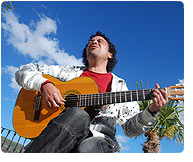|
|
 |
 Heartstrings: Medieval Lutes, Twilit Clubs, and Deep Romance Ring True on Cuban Troubadour David Álvarez’s Clandestino
Heartstrings: Medieval Lutes, Twilit Clubs, and Deep Romance Ring True on Cuban Troubadour David Álvarez’s Clandestino
David Álvarez sings like a bard of courtly love, locked in a bittersweet court and spark with the tempestuous Lady Love on the streets of Manzanillo. One of Cuba’s young lights, he can evoke the sunny sweetness and lush longing, the Spanish and African past, that runs deep in Cuba’s songs, yet add a rush and pulse that speak of a young, vibrant musical mind.
On Clandestino (Tumi Music; March 13, 2012), Alvarez weaves a tale of love lost, questioned, and savored from the strong Mediterranean threads that run through his native city of Manzanillo’s song traditions, to the gentle thrum of the laúd, the Cuban country answer to the ancient lute of Iberia.
With legendary Cuban players (Irakere’s sax man Alfred Thompson; tres master Pancho Amat; Buena Vista Social Club’s Roldán Carballoso Gomez) rounding out his ensemble of top performers, with a rising cry or a delicate whispering tremolo, with soft-spoken percussion and dramatic musicianship, Álvarez urges love to find a way though doubt and distress.
“For me, composing songs is the way to rescue those beautiful moments, when life is lived without prejudices and big questions are asked with the innocent belief that everything is possible,” smiles Álvarez. “This album is a return to those places and times that, in my short life, I turn to regularly, places that give me hopeful energy and endless inspiration.”
{full story below}
Some of the places that inspired Álvarez as he began imagining his long-standing dream for the album lie in Manzanillo, the home of Cuba’s influential trova song style. He would linger around jukeboxes in old clubs, while his dad played him chestnuts from his youth. He would go to dance parties and bars that hadn’t changed a lick from the 1940s. He would hang out all night and busk in the city’s well-loved parks.
“Trova was a very vibrant scene, both the old and new styles, when I was young in Manzanillo,” Álvarez recalls fondly. “I memorized a lot of the repertoire I heard then.”
Yet like many young Cuban musicians, Álvarez wanted to find new angles and means of expression within the time-honored traditions of his home. Enter the revered icon of trova innovation, Pedro Luis Ferrer, who mentored Álvarez as a member of his group. From the indomitable, outspoken Ferrer, Álvarez notes, “I learned not to make concessions when it came to making good art and the importance of consistency in my thinking. I learned to remember that music is the vehicle to bring my thoughts and feelings to light and that music should be a beautiful gift for those who listen.”
Álvarez began to find his own voice, working with fellow musicians and friends from Ferrer’s circle and creating their own, soon very hot group, Juego de Manos. Now in the original compositions on Clandestino, Álvarez pairs his youthful energy with an uncanny ability to channel the twilit spirit of his favorite haunts and Cuba’s rural campesino traditions.
To bring the right feel to this diverse sweep of romantic songs, Álvarez invited new collaborators from the ranks of legendary Cuban bands to join his core group. He knew he needed to add (among other instruments) the laúd, an instrument traditionally associated with country styles and with ancient ties to the Canary Islands and Spain. An instrument that sings in the hands of Buena Vista Social Club’s Roldán Carballoso Gomez.
“To me, there is not a more transparent and sweeter instrument than the laúd,” Álvarez explains. “It is one of the central timbres in Cuban country music, though it doesn’t get used in the usual way in these songs. Instead of the typical 3/4 or 6/8 rhythms, its voice brings to the album the spirit of the tonada guajira, a Cuban music style from the countryside closer to Spanish music than African. It imparts a Mediterranean flavor and the feelings of Medieval and Baroque music, where its past lies.” This history finds fresh form as the laúd and guitar join forces on “La Tarde,” a wistful ode to the evening, when the muse often comes closest.
Yet Álvarez combines the gentle sweetness of strings with a bold pan-Latin flair, be it in the dramatic, almost cinematic opening of ”El Alma” or the fire-and-ice of piano and brass on “Distancia.” He hints at the pulse of Andean charango, and calls to Cuba’s African spiritual heritage in “Musa del Río,” beckoning the muse-like orisha of rivers to enrich his creative efforts.
Inspired by Latin artists from Argentine singer Mercedes Sosa to Chile’s Victor Jara, Álvarez notes, “When their music meet the varied roots that my little island feeds me with, it sparks songs and also deeply informs the person I am,” a joyful troubadour, turning nostalgic street corner sounds into artful Latin hymns to love’s complexities.
<< release: 03/13/12 >>
|
|
 |
|
|
|